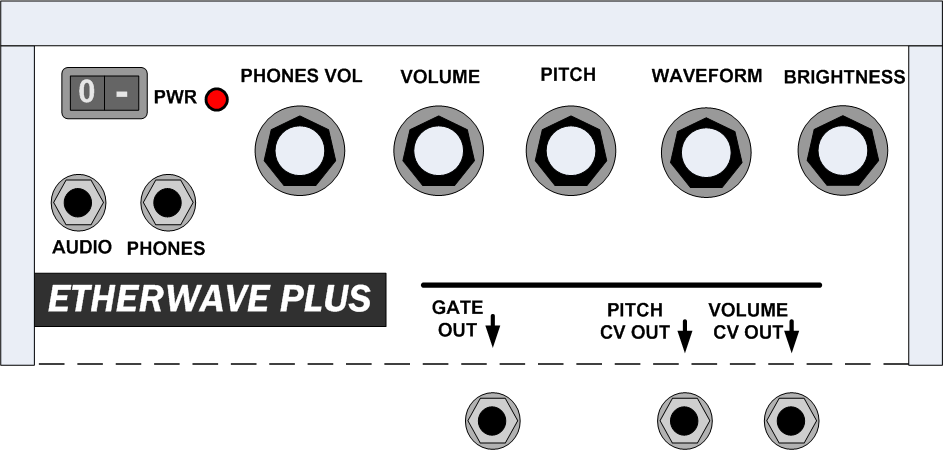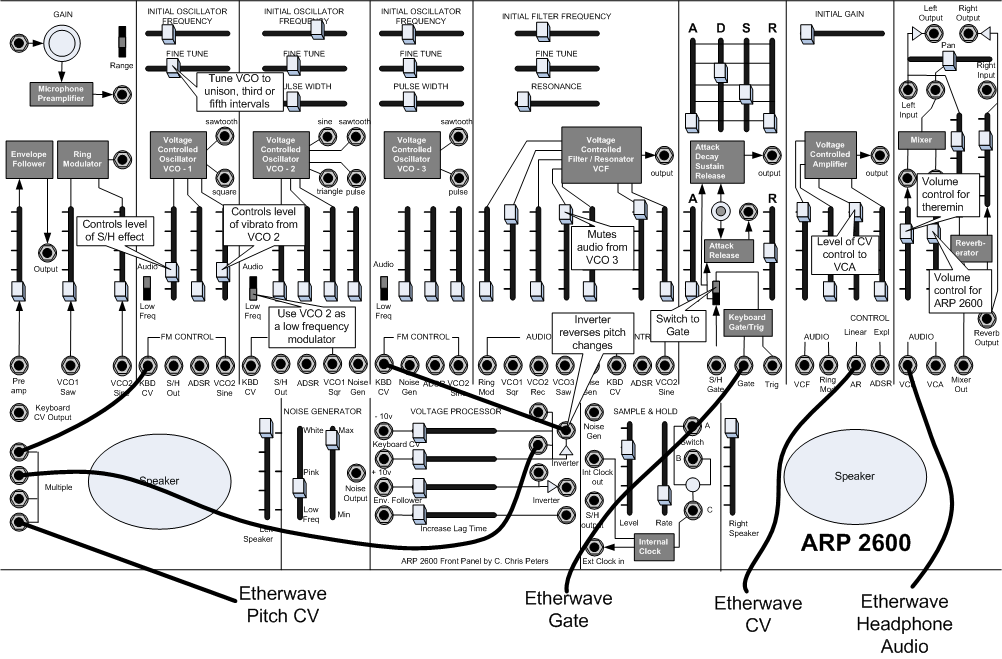
Using a Theremin to Control a Synthesizer
By C. Chris Peters
This article describes how to connect a Moog Etherwave Plus theremin to an ARP 2600 analog synthesizer. The theremin is used to play the synthesizer instead of its keyboard. The Etherwave's pitch antenna controls two of the ARP 2600's voltage controlled oscillators and its volume antenna controls the filter and volume functions.
Moog Music currently manufactures two models of the Etherwave theremin, the Etherwave and the Etherwave Plus. The Etherwave Plus model has external hardware output jacks that allow performers to play voltage controlled equipment like analog synthesizers from the theremin. Earlier Etherwave (non-plus) models can be upgraded via a kit available from Moog Music.
The added “Plus” features include:
Etherwave Control Output Descriptions:
Below is a diagram of the Moog Etherwave Plus control panel. The three voltage
control interface jacks are located on the underside of the instrument.

Instrument Patch Cord Compatibility
The ARP 2600 is an early semi-modular instrument that was made before personal computers and MIDI came into existence, so it only understands analog voltages. All the ARP 2600's functional modules can be directly accessed electrically from its front panel using patch cord cables and jack connections. The ARP 2600s uses mini-jack connections which are smaller than regular quarter inch sized connections electric guitars use.
The Etherwave uses standard quarter inch connections. Fortunately, “adapter” cables are available at most consumer electronic retail stores that also sell small parts like Radio Shack. These cables have two different sized male connections, a mini on one end and a quarter inch on the other.
To make the proper interface connections you will need:
Six foot cable lengths are fine.
Below is a facsimile of the ARP 2600’s control panel showing the configuration I use as a standard when connecting the Etherwave Plus to the ARP 2600. This configuration allows you to control two Voltage Controlled Oscillators from the theremin’s pitch antenna, initiate the Envelope Generators and dynamically control the volume of the synthesizer’s audio output. You can also monitor the theremin’s audio output through the synthesizer's internal speakers.

The callouts indicate slider controls whose positions can be varied for different effects and point out important switch positions. Slider positions that are fully down or to the left indicate that their settings will not affect the interface patch. The black lines indicate path chord cable connections.
Connection Description:
The Etherwave’s Pitch CV output, which is controlled from the theremin’s pitch antenna, is connected to the Multiple or parallel fields inputs on the ARP 2600. The multiple splits the control voltage signal from the theremin to control two oscillators at once. The left most oscillator (VCO 1) is connected directly from the multiple. The control voltage connection to the right most oscillator (VCO 3) passes first through the Voltage Processor’s Inverter and then to VCO 3. The Inverter reverses the voltage control response. When the audio from VCO 3 is turned on, its frequency will decrease instead of increasing as you move your hand towards the pitch antenna.
The Etherwave’s Gate output is connected to the ARP 2600's Gate input. I usually have the toggle switch on the ARP 2600’s Envelope (ADSR / AR) section in the up position. When in the down position the S/H Gate input jack must be connected.
The Etherwave’s other CV output which is controlled from the theremin’s volume antenna, is connected to the ARP 2600’s Voltage Controlled Amplifier using the Linear AR input jack. I recommend that the Linear Control slider be turned up to maximum to start. You can always reduce the level depending on the response of the volume antenna.
I connect the Etherwave’s Phone audio output to the ARP 2600's VCF input jack on the synthesizer's Output mixer section. The advantage with using the headphone audio output is that it allows convenient control of the theremin’s audio output from the Etherwave's control panel instead of reaching across to the ARP 2600’s panel. This helps when you want to balance the outputs of the theremin and the synthesizer during live performances.
© C. Chris Peters 2010
- cchrispeters.com